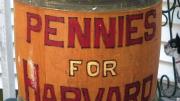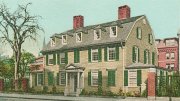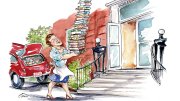As fair harvard thrusts its tin cup at you in this reunion season, be mindful of the following early instance of philanthropy rewarded. In 1648, Puritans in Massachusetts learned that a band of brethren, religious exiles from Bermuda who were attempting to colonize the Bahamian island of Eleuthera, had come to grief through shipwreck and other misfortunes, were starving, and were in desperate need of succor. The churches of Boston and thereabouts raised a fat sum (estimated between £600 and £700) for provisions, which they shipped south on May 13, 1650, in a small chartered vessel. It reached Eleuthera on June 17.
The rescued brethren plied their axes and sent the ship back to Boston filled with 10 tons of brazilwood, a source of red dye. As Samuel Eliot Morison tells the story in Harvard in the Seventeenth Century, a very long letter accompanied the wood. “After several pages of pious ejaculations, biblical references, expressions of gratitude, and general sermonizing,” Morison writes, the Eleutherans declared that they were sending the wood to “avoid that foule sin of ingratitude so abhorred of God, so hatefull to all men.” They specified that the wood was to be disposed of for the benefit of Harvard College. This provision was doubtless orchestrated by Nathaniel White Jr., A.B. 1646, son of the Eleutheran pastor, who had sailed to the island with the provisions and back to Boston with the wood. “Harvard graduates,” Morison notes, “have a way of diverting any benefactions that may be floating about into the ever empty coffers of alma mater.”
Harvard sold the brazilwood for £124 and used the money to expand. The College bought the house, lot, and cowyard of Edward Goffe, which adjoined the original Yard to the west, and remodeled the house into chambers and studies for students. Young White resumed residence in college to further his studies, and the administration awarded him a scholarship, the only instance on record of such a grant to a graduate student not engaged in teaching.
This magazine reported on February 2, 1957, that some “Harvard Friends of Eleuthera” had just presented the Bahamas a 14-inch-square plaque of brazilwood with a brass plate attached, commemorating the exchange of gifts almost three centuries earlier. It is said to hang to this day in Eleuthera’s public library.
In 1980, a schooner from the Abacos arrived in Boston to represent the Bahamas in a Tall Ships celebration and carried aboard a plaque recalling the gift of brazilwood to Harvard. A photograph in the Harvard Gazette of May 30 shows the Bahamian ambassador to the United States handing the plaque to the executive director of the Harvard Alumni Association. Primus has yet to discover its present whereabouts.
Damnable bills. Before it got Goffe, Harvard had only one building, the Old College. It was demolished about 1679, and no one knows exactly what it looked like. Four scholars affiliated with Harvard’s Peabody Museum of Archaeology and Ethnology write in a chapter of a new book, Beneath the Ivory Tower: The Archaeology of Academia, that excavations at the site in the 1980s uncovered assorted broken remains of the building, including “an especially high concentration of window glass.…Historical documents mention major episodes of glass breaking at the College in 1651/52 and the following year,” they note, “but the reason for these events is unclear.... There are also references to glass breaking at quarter-days, the final day of each fiscal quarter at the college, when each student was presented with a bill that was to be paid within a month’s time. Students are known to have protested their charges by breaking windows.”









